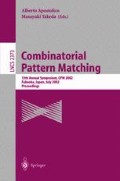Abstract
There is a pressing need to align growing set of expressed sequence tags (ESTs) to newly sequenced human genome that is still frequently revised, for providing biologists and medical scientists with fresh information. The problem is, however, complicated by the exon/intron structure of eucaryotic genes, misread nucleotides in ESTs, and millions of repeptive sequences in genomic sequences. Indeed, to solve this, algorithms that use dynamic programming have been proposed, in which space complexity is O(N) and time complexity is O(MN) for a genomic sequence of length M and an EST of length N, but in reality, these algorithms require an enormous amount of processing time. In an effort to improve the computational efficiency of these classical DP algorithms, we develop software that fully utilizes the lookup-table that stores the position at which each short subsequence occurs in the genomic sequence for allowing the efficient detection of the start-and endpoints of an EST within a given DNA sequence, and subsequently, the prompt identification of exons and introns. In addition, high sensitivity and accuracy must be achieved by calculating locations of all spliced sites correctly for more ESTs while retaining high computational efficiency. This goal is hard to accomplish in practice, owing to misread nucleotides in ESTs and repeptive sequences in the genome, but we present a couple of heuristics effective in settling this issue. Experimental results have confirmed that our technique improves the overall computation time by orders of magnitude compared with common tools such as sim4 and BLAT, and attains high sensitivity and accuracy against datasets of clean and documented genes at the same time. Consequently, our software is able to align about three millions of ESTs to a draft genome in less than one day, and all the information is available through the WWW at http://grl.gi.k.u-tokyo.ac.jp/.
Access this chapter
Tax calculation will be finalised at checkout
Purchases are for personal use only
Preview
Unable to display preview. Download preview PDF.
References
J. Craig Venter et al. The sequence of the Human Genome Science, 291:1304–1351 (2001)
International Human Genome Sequencing Consortium. Initial sequencing and analysis of the human genome Nature, 409:860–921 (2001)
S. B. Needleman and C. D. Wunsch. A general method applicable to the search for similarities in the amino acid sequence of two proteins. Journal of Molecular Biology, 48:443–453 (1970)
T. F. Smith and M. S. Waterman. Identification of common molecular subsequences. Journal of Molecular Biology, 147:195–197 (1981)
W. R. Pearson and D. J. Lipman. Improved tools for biological sequence comparison. Proceeding of the National Academy of Sciences, 85:2444–2448 (1988)
S. F. Altschul, W. Gis, E. W. Myers, and D. J. Lipman. Basic local alignment search tool. Journal of Molecular Biology, 215:403–410 (1990)
O. Gotoh. An improved algorithm for matching biological sequences. Journal of Molecular Biology, 162:705–708 (1982)
Daniel S. Hirschberg. A Linear Space Algorithm for Computing Maximal Common Subsequences. CACM 18(6): 341–343 (1975)
M. S. Gelfand, A. A. Mironov, and P. A. Pevzner. Spliced alignment: A new approach to gene recognition. Proc. Natl. Acad. Sci. 93:9061–9066 (1996)
E. Birney and R. Durbin. Dynamite: a flexible code generating language for dynamic programming methods used in sequence comparison. Proc. Fifth Int. Conf. Intelligent Systems Mol. Biol. 5:55–64 (1997)
R. Mott. EST_GENOME: A program to align spliced DNA sequences to unspliced genomic DNA. Comput. Appl. Biosci. 13:477–478 (1997)
L. Florea, G. Hartzell, Z. Zhang, G. M. Rubin, and W. Miller. A computer program for aligning a cDNA sequence with a genomic sequence. Genome Research, 8(9):967–974 (1998)
W. James Kent. UCSC Human Genome Browser, http://genome.ucsc.edu/
M. Burset and R. Guigo. Evaluation of gene structure prediction programs. Genomics, 34:353–357 (1996).
T. A. Thanaraj. A clean data set of EST-confirmed splice sites from Homo sapiens and standards for clean-up procedures. Nucl. Acids. Res. 27: 2627–2637 (1999).
F. Clark and T. A. Thanaraj. Categorization and characterization of transcript-confirmed constitutively and alternatively spliced introns and exons from human. Hum. Mol. Genet. 11: 451–464 (2002)
M. Burset, I. A. Seledtsov, and V. V. Solovyev. SpliceDB: database of canonical and non-canonical mammalian splice sites. Nucl. Acids. Res. 29: 255–259 (2001).
S. Rogic, A. Mackworth and F. Ouellette. Evaluation of gene finding programs. Genome Research, 11: 817–832 (2001).
T. Honkura, J. Ogasawara, T. Yamada, and S. Morishita. The Gene Resource Locator: gene locus maps for transcriptome analysis. Nucl. Acids. Res., 30(1):221–225 (2002)
Author information
Authors and Affiliations
Editor information
Editors and Affiliations
Rights and permissions
Copyright information
© 2002 Springer-Verlag Berlin Heidelberg
About this paper
Cite this paper
Ogasawara, J., Morishita, S. (2002). Practical Software for Aligning ESTs to Human Genome. In: Apostolico, A., Takeda, M. (eds) Combinatorial Pattern Matching. CPM 2002. Lecture Notes in Computer Science, vol 2373. Springer, Berlin, Heidelberg. https://doi.org/10.1007/3-540-45452-7_1
Download citation
DOI: https://doi.org/10.1007/3-540-45452-7_1
Published:
Publisher Name: Springer, Berlin, Heidelberg
Print ISBN: 978-3-540-43862-5
Online ISBN: 978-3-540-45452-6
eBook Packages: Springer Book Archive

